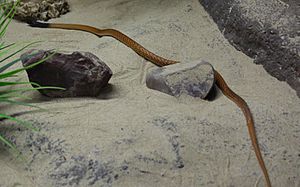Western brown snake facts for kids
Quick facts for kids Western brown snake |
|
|---|---|
 |
|
| Conservation status | |
| Scientific classification | |
| Genus: |
Pseudonaja
|
| Species: |
mengdeni
|
The western brown snake (Pseudonaja mengdeni) is also known as Mengden's brown snake or gwardar.
This snake lives only in Australia. It can look very different from one snake to another, with many colors and patterns. It is a very dangerous snake, and its bite can cause serious problems, even death. The western brown snake is one of three species that were once thought to be the same as the Pseudonaja nuchalis, along with the P. aspidorhyncha and P. nuchalis.
Contents
About the Western Brown Snake
Before, scientists thought the western brown snake was just a different form of Pseudonaja nuchalis. But new studies looking at their genetics (their DNA) show that it is actually its own unique species.
Scientists believe there might be more than 10 different species within the Pseudonaja nuchalis group. So far, they have found 8 species by looking at their chromosomes. These include P. aspidorhyncha, P. mengdeni, P. imperator, P. acutirostris, P. gowi, P. carinata, P. kellyi, and P. nuchalis.
What It Looks Like
The western brown snake can grow up to 2 meters (about 6.5 feet) long. Most are around 1.2 meters (about 4 feet) long. It has a thin body and a narrow head.
These snakes come in many colors and patterns. They can be light brown to almost black. Some have a special look: either orange with a black head, or a pale head with a grey neck. Their belly is often cream, yellow, orange, or grey, sometimes with dark orange or grey spots.
The scales on its head often form a black V or W shape. It can be hard to tell the western brown snake apart from the Eastern brown snake (which has a pink mouth) or the Northern brown snake (which has a purplish-blue mouth). The western brown snake has a special large scale near the front of its snout.
To correctly identify this snake, experts count the scales on its body and lips. It has 180-230 scales on its belly (ventral scales), 45-70 scales under its tail (subcaudals), a split anal scale, and 17 or 19 rows of smooth scales around its middle. Only an experienced herpetologist (a reptile expert) should do this. Even a small scratch from its fangs can be very dangerous.
Sometimes, different Pseudonaja species can breed together, which makes it even harder to tell them apart. People also sometimes confuse the western brown snake with the black-headed python.
Where It Lives and Its Home
You can find the western brown snake from the coast of Western Australia all the way through central Australia. It also lives in the north-west of New South Wales and western Queensland. We don't know exactly how far north it goes. However, it does not live in the wetter parts of eastern Australia or south-western Western Australia.
The western brown snake lives in almost all dry areas. This includes woodlands, sandy areas, deserts with spinifex grass, sandplains, and stony plains. They also live in farmlands, grasslands, and sclerophyll forests. You can often find them hiding in fallen logs, dead trees, bushes, native grasses, and holes in the ground.
What It Eats
The western brown snake hunts and eats small reptiles, mammals, other snakes, and birds that nest on the ground. It also eats bird eggs.
Reproduction
The western brown snake is oviparous, which means it lays eggs. A female can lay more than 12 eggs at one time.
Venom and Safety
The western brown snake has very dangerous venom. Its bite can cause severe problems and can even be deadly. It is considered a highly venomous snake.
If someone is bitten by a western brown snake, they need to get help right away. First aid should be given, and medical attention must be sought immediately. There is a special Antivenom for brown snake bites that doctors use.
How It Behaves
When the western brown snake feels threatened, it will lift the front part of its body into an S-shape. It will also lift its head off the ground and open its mouth. This snake lives on the ground and is usually active during the day. However, it can also be active on warm nights.
Images for kids





